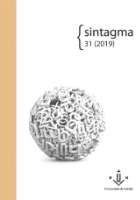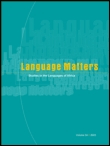
Revista Espanola de Linguistica Aplicada
Scope & Guideline
Exploring innovative approaches in applied linguistics.
Introduction
Aims and Scopes
- Interdisciplinary Approaches to Language Studies:
The journal emphasizes interdisciplinary research, integrating insights from linguistics, education, translation studies, and sociolinguistics to address complex language-related issues. - Corpus-based and Empirical Research:
A significant focus is placed on corpus-based studies, utilizing large datasets to analyze language use, variation, and change across different registers and contexts. - Language Teaching and Learning:
Research addressing language pedagogy, including second language acquisition, teaching methodologies, and learner perceptions, is a core area, reflecting contemporary challenges in language education. - Translation and Interpretation Studies:
The journal publishes work on translation practices and interpretation, exploring theoretical frameworks as well as practical applications in various contexts, including healthcare and education. - Sociolinguistics and Language Variation:
The exploration of sociolinguistic phenomena, including language attitudes, identity construction, and the impact of social factors on language use, is a prominent theme.
Trending and Emerging
- Digital Communication and Interaction Analysis:
There is a growing focus on the analysis of digital communication, including how language is used in online contexts, reflecting the impact of technology on language practices. - Metaphor and Discourse Analysis:
Recent studies emphasize metaphorical language and its role in shaping discourse, especially in political and health communication, indicating a trend towards understanding language's influence on perception. - Language and Identity:
Research exploring the intersection of language and identity, particularly in multilingual and multicultural contexts, is increasingly prominent, reflecting contemporary social dynamics. - Linguistic Accessibility and Universal Design for Learning (UDL):
An emerging theme is the focus on making language education more accessible through UDL principles, highlighting the importance of inclusivity in language teaching. - Pragmatics and Contextual Language Use:
There is a notable increase in studies examining pragmatics and the role of context in language use, particularly in educational settings and language acquisition.
Declining or Waning
- Traditional Linguistic Theory:
Research that strictly adheres to traditional linguistic theories without incorporating modern empirical methods or interdisciplinary perspectives seems to be less frequent. - Static Language Models:
Studies focusing solely on static or prescriptive models of language are declining, as there is a growing preference for dynamic approaches that consider language in use and variation. - General Linguistics:
Papers focusing on broad, theoretical discussions of linguistics without practical application or empirical backing are becoming rarer, reflecting a shift towards more applied research. - Historical Linguistics:
Research in historical linguistics has seen a decrease, possibly due to the increasing emphasis on contemporary language issues and applications in education and technology. - Language and Culture without Empirical Support:
Discussions of language and culture that lack empirical studies or quantitative analysis are becoming less common, as the journal moves towards research grounded in data.
Similar Journals

Al-Arabiyya-Journal of the American Association of Teachers of Arabic
Transforming Arabic Education with Groundbreaking InsightsAl-Arabiyya: Journal of the American Association of Teachers of Arabic, published by Georgetown University Press, serves as a significant platform for research and scholarship in the fields of Arabic language education, linguistics, and literature. With its ISSN 0889-8731 and E-ISSN 2375-4036, this journal presents a robust blend of original articles, reflections, and pedagogical research aimed at both seasoned educators and emerging scholars. While the journal is not an open-access publication, it maintains a commendable impact in its categories, achieving Q4 in Education and Q2 in Literature and Literary Theory as per the latest rankings. Notably, it has been recognized within Scopus for its contributions to the arts and humanities, with rankings that reflect a vibrant academic discourse surrounding the Arabic language. Al-Arabiyya aims to promote and enhance the teaching and learning of Arabic while fostering an understanding of its literary and cultural richness, making it an invaluable resource for anyone interested in Arabic studies.

Forma y Funcion
Fostering dialogue and discovery in language studies.Forma y Funcion is a distinguished open access journal published by UNIV NACIONAL COLOMBIA, FAC CIENCIAS HUMANAS, dedicated to advancing the fields of linguistics and language studies. With an ISSN of 0120-338X and an E-ISSN of 2256-5469, the journal has been committed to open access since 2005, ensuring that research is freely accessible to scholars, professionals, and students around the globe. Situated in Bogotá, Colombia, it has established itself as a pivotal platform within the academic community, achieving a commendable Q2 ranking in 2023 in the subfield of Linguistics and Language. Its Scopus rankings further underscore its relevance, placing it in the 55th percentile among peers in the Arts and Humanities and the 51st percentile within Social Sciences. Covering a range of topics related to language and linguistics, Forma y Funcion aims to foster cutting-edge research and dialogue, making significant contributions to the field from 2019 through 2024 and beyond.

Sintagma
Navigating the Evolving Landscape of Language.Sintagma is a prominent academic journal dedicated to advancing the field of Linguistics and Language, published by the Universitat de Lleida in Spain. With an ISSN of 0214-9141 and an E-ISSN of 2013-6455, this journal has established itself as an open-access platform since 1989, thereby ensuring wide accessibility and dissemination of research. The journal's commitment to quality is reflected in its ranking within the Q4 quartile of Linguistics and Language in 2021 and a similar standing in Social Sciences and Arts and Humanities, which underscores its emerging importance in these fields despite recent challenges. Covering topics that span theoretical inquiries to applied linguistic studies, Sintagma invites researchers, professionals, and students to contribute to and engage with its evolving landscape from its unique academic perspective. With the convergence of research years from 2011 to 2018 and upcoming issues through 2024, the journal remains poised to provide insightful content that addresses the linguistic dimensions of contemporary society.

Argentinian Journal of Applied Linguistics
Exploring the intersections of language, culture, and education.The Argentinian Journal of Applied Linguistics is a prominent publication dedicated to advancing the field of linguistics with a particular focus on practical applications within various contexts. Published by the Federación Argentina de Asociaciones Profesionales de Profesores de Inglés (FAAP), this journal serves as a vital platform for researchers, educators, and linguistics professionals interested in the nuances of language teaching, acquisition, and sociolinguistics. With an ISSN of 2314-3576, the journal showcases original research and reviews that push the boundaries of current knowledge and practice in applied linguistics. Despite being in its early stages, the journal aims to build a strong academic presence by fostering collaboration among scholars and practitioners, thereby contributing to the enhancement of language education in Argentina and beyond. The importance of this journal lies not only in its commitment to accessibility and knowledge dissemination but also in its role as a bridge between linguistic theory and practical application, ultimately benefiting educators and learners alike.

Onomazein
Bridging Cultures Through the Study of LanguageOnomazein is an esteemed academic journal published by the Pontificia Universidad Catolica de Chile, Facultad de Letras, featuring a dedicated focus on the field of Linguistics and Language. With an established presence since 2011, it reaches an international audience and is recognized for its contributions within the Q2 category of Linguistics as per the latest rankings, underscoring its significance in the academic community. The journal holds a commendable position in Scopus, ranking 470th out of 1088 in Arts and Humanities and 549th out of 1167 in Social Sciences, reflecting its relevance and impact in the domain. Although it does not currently offer an open access option, Onomazein remains a critical platform for researchers, professionals, and students seeking to advance their understanding of linguistic phenomena and engage with contemporary debates in language studies. For submissions and more information, please refer to the university’s address at AV Vicuna Mackenna 4860, Santiago, Chile.

Chuzhdoezikovo Obuchenie-Foreign Language Teaching
Connecting Scholars in Foreign Language EducationIntroducing Chuzhdoezikovo Obuchenie - Foreign Language Teaching, a prominent journal published by NATSIONALNO IZDATELSTVO AZ BUKI, dedicated to the field of foreign language education. With its ISSN 0205-1834 and E-ISSN 1314-8508, this journal aims to provide a comprehensive platform for researchers, educators, and practitioners to share insightful studies, innovative methodologies, and transformative practices in language teaching. The journal is based in Sofia, Bulgaria and is strategically positioned to contribute to the discourse on language acquisition and pedagogy, targeting a global audience interested in enhancing foreign language competencies. Although specific impact factors and H-index data may be unavailable, the journal's commitment to quality and relevance in the field is evident through its rigorous peer-review process, ensuring that published works meet high academic standards. Emphasizing accessibility and inclusivity, Chuzhdoezikovo Obuchenie invites submissions that reflect contemporary challenges and advancements in language education, making it an essential resource for anyone invested in the future of multilingual instruction.

RAEL-Revista Electronica de Linguistica Aplicada
Bridging Linguistics and Practical SolutionsRAEL-Revista Electronica de Linguistica Aplicada, published by the ASOC ESPANOLA LINGUISTICA APLICADA-AESLA, is a prominent open access journal that has been serving the field of applied linguistics since its inception in 2002. With a dedicated focus on the interplay between language and its practical applications in various contexts, the journal aims to disseminate high-quality research and foster academic discourse among linguists, educators, and policy makers alike. Based in Spain at the Universidad Politécnica de Valencia, RAEL is indexed in Scopus and offers access to a global readership. With a current impact factor reflecting its esteem in the fields of Education, Linguistics, and Social Sciences, the journal ranks in Q3 for linguistics and has achieved significant positioning within its categories. Researchers and students seeking to explore applied linguistic phenomena will find valuable insights and diverse perspectives in its published articles, making RAEL a vital resource in the pursuit of knowledge advancement in this dynamic discipline.

Language Matters
Transforming Perspectives on Language AcquisitionLanguage Matters is a prestigious journal dedicated to the dynamic field of Linguistics and Language, published by Routledge Journals, Taylor & Francis Ltd in the United Kingdom. With an ISSN of 1022-8195 and an E-ISSN of 1753-5395, this journal serves as an essential platform for scholars seeking to explore the multifaceted relationships between language and society. Recognized in the 2023 Category Quartiles as Q2 in Linguistics and Language, it boasts impressive Scopus rankings, sitting at #298 out of 1088 in the Arts and Humanities category and #356 out of 1167 in Social Sciences, highlighting its significant impact on the field with a 72nd and 69th percentile ranking, respectively. The journal's scope encompasses a wide range of topics including language acquisition, sociolinguistics, and psycholinguistics, making it a vital resource for researchers, educators, and students alike. By not offering open access, it maintains a curated selection of high-quality peer-reviewed articles, ensuring that academic rigor and relevance are upheld for its readership. With a publication range spanning from 1993 to 2024, Language Matters continues to shape conversations and advance knowledge in the ever-evolving landscape of linguistic research.

RLA-Revista de Linguistica Teorica y Aplicada
Unveiling new perspectives in theoretical and applied linguistics.RLA-Revista de Linguística Teórica y Aplicada, published by Universidad de Concepción, Facultad de Humanidades y Arte, stands as a vital resource in the field of linguistics, delivering cutting-edge research and scholarly articles that contribute to both theoretical and applied linguistics. With its ISSN 0718-4883, this journal aims to foster robust discussions and innovations in linguistic theory, language acquisition, sociolinguistics, and applied linguistics methodologies. Although the journal currently does not provide open access options, it endeavors to reach a diverse audience, including researchers, professionals, and students, who are keen to explore the rich tapestry of language studies. By offering insights from both local and global perspectives, RLA does not only advance linguistic discourse but also encourages interdisciplinary collaboration, thereby solidifying its role as a pivotal publication in the linguistic academic community.

Eurasian Journal of Applied Linguistics
Exploring Linguistic Connections and Cultural NarrativesThe Eurasian Journal of Applied Linguistics, published by Hacettepe University, ELT Department, is a distinguished open-access journal that has been contributing to the fields of linguistics and language education since 2015. With a focus on bridging cultural and linguistic understandings across Eurasia, this journal provides a platform for researchers, educators, and practitioners to share cutting-edge studies, innovative pedagogical strategies, and insightful analyses. The journal holds notable Scopus rankings within the Language and Linguistics (Rank #155/1088, 85th Percentile) and Education (Rank #696/1543, 54th Percentile) categories, evidencing its growing impact within the academic community. As it prepares to converge into a new phase from 2018 to 2024, the Eurasian Journal of Applied Linguistics aims to uphold its mission of fostering interdisciplinary dialogue and advancing knowledge in applied linguistics and its related fields.